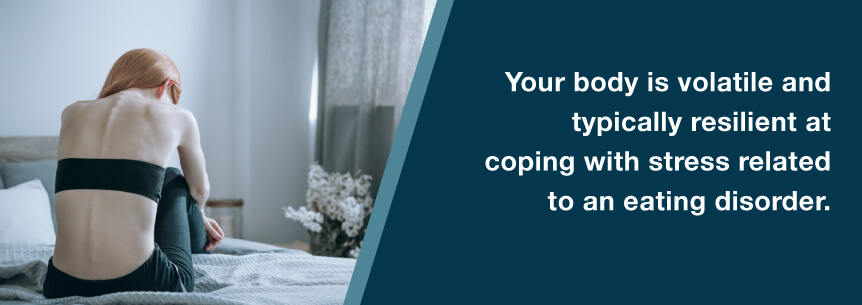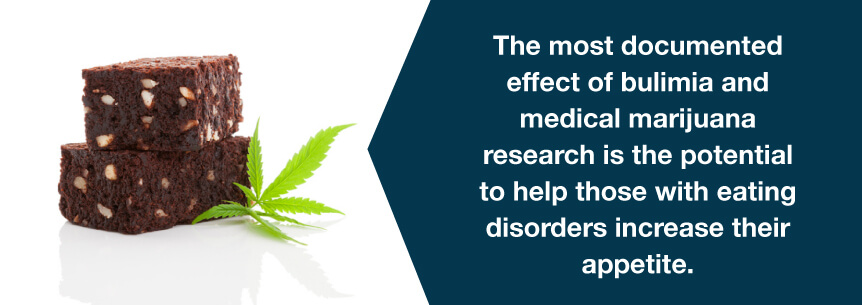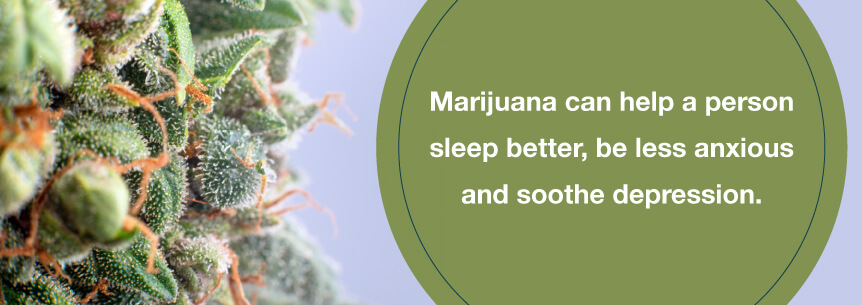
Many people turn to food when they’re bored, lonely, depressed or stressed. However, if you’re struggling with bulimia, you likely overeat not because you love food, but because of a compulsion. Then, you punish yourself with fasting, purging or exercising to rid your body of the calories instead of eating sensibly.
This vicious “binge-and-purge” cycle does a number on both your emotional well-being and your body. The good news is you can break this cycle with the right treatment, support and medical marijuana for bulimia regimen to help you to overcome your feelings of guilt, anxiety and shame, while also developing a healthier relationship with food.
The bulimia nervosa eating disorder is serious and characterized by repeated binge eating episodes, followed by excessive vomiting or exercising to avoid gaining weight. Not only can this repetitive binging and purging cycle create chemical imbalances in your body and cause serious harm to your digestive system, but it can also harm the function of organs like your heart, and even be fatal.
Although younger women tend to struggle with bulimia more commonly, it can also affect both women and men of any age. Life is a continuous battle between an overwhelming binge-eating compulsion and the desire to lose weight when you’re living with an eating disorder. And, even though you don’t want to binge because you feel ashamed and guilty afterward, you continue to give in.
Then, once the binge ends, you go into panic mode and begin taking extreme measures like vomiting, taking laxatives or exercising intensely to “undo” your overeating.
Nobody knows the exact cause of bulimia. Certain factors may play a role, such as:
Most likely, more than a single element causes your bulimia.
There are also certain risk factors potentially increasing your risk of this eating disorder, including the following.

There are two categories of bulimia.
Wealthy individuals in the Middle Ages were the first to reliably describe bulimia, as they would vomit during their feasts to allow them to eat more. The first published clinical paper of this eating disorder was in 1979.
In the 1970s and 1980s, cases of bulimia and anorexia worsened, and while some believe these eating disorders peaked during this time, data from a national survey indicates bulimia cases continue to increase.
Symptoms and signs of bulimia may include:
Bulimia’s repetitive binge-and-purge cycles may affect your whole digestive system and result in chemical and electrolyte imbalances in your body affecting major organ functions, such as your heart.

Your body is volatile and typically resilient at coping with stress related to an eating disorder. Plus, lab testing sometimes comes back normal even when the individual is at a life-threatening stage of their eating disorder. Both electrolyte imbalances and cardiac arrest can kill without warning. So, it’s especially vital you know how eating disorders like bulimia affect your body.
Potential complications of bulimia include:
A thought-provoking development in the treatment of eating disorders is the growing awareness of how frequently mood disorders and anxiety co-occur with eating disorders, and how infrequently they occur separately.
Anxiety disorders commonly co-occur with eating disorders. In fact, a national survey in 2007 indicated 80.6 percent of bulimia patients at one point also struggled with an anxiety disorder. Depression is also common among bulimics.
According to the National Association of Anorexia Nervosa and Associated Disorders, statistics relating to bulimia include:
Your doctor will first want to perform some exams and run some tests. For instance, a dental exam will show if there are any gum infections or cavities. The acid in vomit can cause teeth enamel to wear.
A physical exam will show your doctor if there are any signs of:
With bulimia nervosa, you might require a few different treatments, but combining antidepressants and psychotherapy seems to be the most ideal and effective treatment plan to overcome the disorder.
Your treatment plan will likely involve a team approach which will include:
In some cases, you might have a case manager who coordinates your care.
Different treatment options for bulimia may include the following.
Psychotherapy, also called psychological counseling or talk therapy, involves you sitting down with a mental health provider and talking about your bulimia and other related problems. Evidence reported by the Mayo Clinic shows certain types of psychotherapy are helpful in bulimia cases and improving symptoms. The different types of psychotherapy may include the following.
Your mental health provider will decide which psychotherapy is most appropriate and beneficial for your bulimia case.
Antidepressants can help reduce bulimia symptoms when combined with psychotherapy. Fluoxetine (Prozac) is the only FDA-approved antidepressant for treating bulimia. It’s an SSRI, or selective serotonin reuptake inhibitor, designed to help even when you don’t have depression. Side effects of Prozac include:
Your health care provider and dietitian will work closely with you to come up with an eating plan to help you gain normal eating habits, a healthy weight and good nutrition. A medically supervised program for weight loss may benefit you if you have bulimia.
Typically, doctors can treat bulimia outside of the hospital. However, with severe forms of bulimia and serious health complications, hospitalization may be indicated. But, instead of inpatient hospitalization, some eating disorder programs do provide day treatment.
While most individuals recover from bulimia, some have symptoms that don’t entirely go away. You may have brief binge-and-purge periods throughout your life, depending on the circumstances, such as times of high stress.
It’s possible to regain control from periodic binge-and-purge cycle episodes through “booster” sessions. You’ll work closely with your health care provider in these sessions to learn positive ways to cope, manage your stress and create healthy relationships to help prevent relapse.
The most documented effect of bulimia and medical marijuana research is the potential to help those with eating disorders increase their appetite. Not only is increased appetite virtually universally reported among marijuana and medical marijuana users, but it is also one of the few wholly understood reactions to the drug.

The human body produces endocannabinoids naturally, and the body has countless receptors for them. We are just now beginning to understand the role these endocannabinoids play in body chemistry, and one role appears to be appetite control. Cannabinoids attach to the same receptors as endocannabinoids, meaning they can impact the same sensations affected by the body’s natural endocannabinoids, such as hunger.
While you would think cannabis “munchies” would be an unwanted side effect for those with bulimia because it would mean more purging, this isn’t exactly the case. Medical marijuana provides bulimia patients with a sense of pleasure in their eating because it activates receptors in the insula, making the individual less likely to purge.
Rather than feeling guilty, medical marijuana for bulimia helps individuals enjoy the eating process. Plus, medical weed distracts the bulimic from the mental anguish of their eating disorder. Using marijuana and bulimia treatment, you can replace the binging and purging patterns with the ritual of cannabis and its calming effects. By reducing anxiety, marijuana can help lead to recovery.
Furthermore, studies show medical pot users have:
Therefore, cannabis for bulimia may play a role in lowering BMI and fat to reduce the risk of diabetes.
Physical symptoms of bulimia include binging and purging. A person with bulimia may also eat a normal diet without binging or eat very little, as with a person who has anorexia. Medical marijuana is proven to increase appetite as one of the primary side effects of the marijuana plant and THC. Therefore, marijuana can increase appetite in individuals with bulimia who do not eat enough. However, bulimics should also undergo psychotherapy to ensure the purging behavior ceases.
Another physical symptom of bulimia nervosa is increased exercise. This symptom is not present in all bulimia sufferers and is not necessarily a bad thing. A problem arises, however, when someone exercises more often than their body can handle. If the body is not getting enough nutrients, exercise will sap what is left. A frail person with bulimia can suffer organ damage through lack of nutrients. Increased exercise, in extreme cases, can result in death through various organ malfunctions and failures.
Medical marijuana may be able to help in this department by calming the manic energy driving a person with bulimia to continue exercising, despite the body’s protests. Marijuana stereotypically makes a person less motivated. While this is a stereotype and not always true, it is often true while the effects are taking place. With the help of a doctor, bulimia sufferers can try this method of decreasing obsessive behavior.
Bulimia sufferers can potentially run the range of negative emotional symptoms. They can be manic, depressed, anxious, self-medicating, moody and disinterested in activities that do not further their weight-loss goals. Medical marijuana is not likely to work as a sole treatment for these symptoms. However, in general, it can help a person sleep better, be less anxious and soothe depression. Because medical marijuana has been shown to cause some of these symptoms, it’s best bulimia sufferers do not self-medicate. A medical professional should supervise and monitor the effects medical marijuana is having on a patient.

You can talk to your budtender or physician about medical cannabis for bulimia strains with higher CBD levels, and lower or no THC. Some cannabis strains include:
Not all individuals like to smoke, particularly those for whom smoking isn’t an option due to compromised lung health. The stigma around smoking may be the one thing stopping individuals from trying medical marijuana, even if they live in a state where the herb is legal.
Although there are various ways of consuming marijuana for bulimia, you might be seeking more health-conscious options. Below are some recommendations for a smoke-free marijuana experience.
Now that you are familiar with the different methods of use and strains of cannabis and bulimia treatment options, it’s time for you to search for a medical cannabis doctor and find a dispensary. Try our location finder at MarijuanaDoctors.com to consult with a medical pot doctor and find the products you need for you to benefit from your choice of smoke-free cannabis consumption.
Our qualified doctors and professional cannabis team will be more than happy to answer all of your questions and guide you in the right direction as far as choosing strains and cannabis products right for your particular symptoms.
Find A Doctor Find A Dispensary